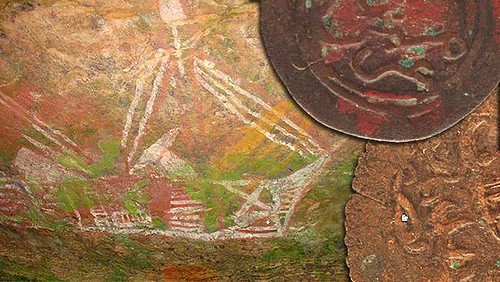
PREV ARTICLE
NEXT ARTICLE
FULL ISSUE
PREV FULL ISSUE
WESSEL ISLANDS SEARCH YIELDS SOME CLUES TO COIN ORIGINS
Earlier E-Sylum articles reported on the expedition to Australia in search of answers to a long-ago find of African coins. Here's an update.
-Editor

One of the rock art paintings discovered during last month's expedition to the Wessel Islands and, inset, two of the medieval African coins that sparked the search. IT'S an adventure story involving medieval African coins, a confusing map and some of Australia's most rugged coast. But a recent expedition to a remote island off the Northern Territory has the potential to rewrite Australia's history. An expedition sponsored by Australian Geographic last month travelled to the remote Wessel Islands to find the spot where five 1000-year-old African coins were discovered by a curious RAAF serviceman in 1944. While they didn't find more coins, what they did find has already inspired a return expedition to the islands next year in the hope of rewriting the history of the first seafarers to reach Australia's shores. Rock art pictures of sailing vessels and unusual men, along with intriguing samples of washed up shipping timbers and metalwork are being examined ahead of a return to the area next year to explore waters around the island for wrecks. The researchers are actively exploring the possibility that the African coins came from a medieval Arab trading ship plying a route that linked Zimbabwe, Kilwa, Arabia, Persia, India and islands in the Indonesian archipelago such as Banda and Ambon. Cloves from these islands have been found in 3500-year-old burial pits in Syria and Egypt. The wreck of just such a Persian dhow trading vessel was found off Sumatra in 1998. The coins could also have been from a Portuguese vessel as the seafaring nation conquered the African Kilwa kingdom in 1505 and regularly traded with islands north of Darwin. The first recorded visit of Europeans to the Wessel Islands was by the Dutch in 1623. he team, part of a collaboration between Indiana University and the Australian National University, has sought to increase the chances of a major find by teaching the locals - including the Aboriginal owners of the land, the Warramiri-Golpa clan, indigenous Rangers and NorForce defence personnel - how to recognise historically significant artefacts and sites. The mystery of the medieval coins began 60 years ago when Australian soldier Morry Isenberg was serving at a World War II radar station established on the island to track the Japanese raids on the Top End.
To read the complete article, see:
Search for shipwrecks after medieval coins found in Wessel Islands leads to rock art, possible wreckage
(www.news.com.au/national-news/search-for-shipwrecks-after-medieval-coins-found-in-wessel-islands-leads-to-rock-art-possible-wreckage/story-fncynjr2-1226695924312)
The Numismatic Bibliomania Society is a non-profit organization promoting numismatic literature. See our web site at coinbooks.org. To submit items for publication in The E-Sylum, write to the Editor at this address: whomren@gmail.com To subscribe go to: https://my.binhost.com/lists/listinfo/esylum All Rights Reserved. NBS Home Page Contact the NBS webmaster 
|